AGRICULTURAL SCIENCES PAPER 1 GRADE 12 QUESTIONS - NSC PAST PAPERS AND MEMOS SEPTEMBER 2016
Share via Whatsapp Join our WhatsApp Group Join our Telegram GroupAgricultural Sciences
Paper 1 (P1)
Grade 12
Nsc Past Papers And Memos
September 2016
QUESTIONS
INSTRUCTIONS AND INFORMATION
1. Answer ALL the questions in the ANSWER BOOK.
2. Start EACH question on a NEW page.
3. Read ALL the questions correctly and answer only what is asked.
4. Number the answers correctly according to the numbering system used in this question paper.
5. Non-programmable calculators may be used.
6. Show ALL your calculations, including units and formula, where applicable.
7. Write neatly and legibly.
SECTION A
QUESTION 1
1.1 Various options are provided as possible answers to the following questions. Choose the answer and write only the letter (A to D) next to the question number (1.1.1 to 1.1.10) in the ANSWER BOOK. for example 1.1.11 A.
1.1.1 The following region does NOT form part of the stomach of the pig:
A Cardiac
B Fundus
C Gastric
D Pylorus
1.1.2 Secretion of a digestive juice that contains an amylase deposited into the small intestines occurs in the ...
A liver.
B pancreas.
C salivary gland.
D intestinal gland.
1.1.3 A feed with a total digestible nutrients (TDN) of 85% and a DP of 10% has ...
A high fibre and low DP.
B low fibre and high DP.
C narrow NR and high DP.
D wide NR and low fibre.
1.1.4 The sketch below shows the process that assist in the digestion of a ruminant. 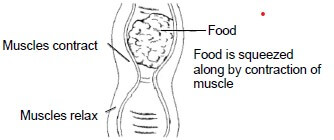
During the process above the following occurs:
Choose the correct combination:
(i) The muscle above the bolus contracts to push the feed downward.
(ii) The muscle below the bolus relaxes to move the feed upward.
(iii) If the rate of the process is reduced, the feed will move slowly leading to constipation.
(iv) The muscle below the bolus relaxes to move the feed downward.
A (i), (iii) and (iv)
B (ii), (iii) and (iv)
C (i), (ii) and (iv)
D (i), (ii) and (iii)
1.1.5 Farm animals are homeothermic because the body temperature is ...
A usually slightly lower than the environment.
B high when environmental temperature is high.
C fluctuating with the fluctuation of environmental temperature. D usually slightly higher than that of the environment.
1.1.6 The eggs of liver flukes are passed from the ... into the faeces.
A bile
B blood
C urine
D lymph
1.1.7 The following statements relates to extensive animal production system:
(i) Large area of land with low production output.
(ii) Low capital input with low production output.
(iii) Low management and control of the environment.
(iv) High production output with high inputs.
Choose the correct combination:
A (i), (iii) and (iv)
B (ii), (iii) and (iv)
C (i), (ii) and (iii)
D (i), (ii) and (iv)
1.1.8 The stage of courtship during mating is characterised by ...
A release of semen into the front part of vagina.
B fleshman response by male animal due to pheromones.
C cow allowing a bull to jump on her.
D pushing of male organ by sigmoidal muscle.
1.1.9 The following statement is NOT a disadvantage of artificial insemination:
A Semen of superior bulls is used.
B Undesirable traits are transferred to the offspring.
C Testing, storage of semen and insemination is expensive.
D Heat detection is difficult under extensive farming conditions.
1.1.10 The correct order in the development of the ovum after fertilisation is ...
A zygote ? blastocyte ? morula ? implantation.
B zygote ? implantation ? blastocyte ? morula.
C zygote ? morula ? implantation ? blastocyte.
D zygote ? morula ? blastocyte ? implantation. (10 x 2)
(20)
1.2 Indicate whether each of the descriptions in COLUMN B applied to A ONLY, B ONLY, BOTH A and B or NONE of the items in COLUMN A. Write A ONLY, B ONLY, BOTH A and B or NONE next to the question number (1.2.1 to 1.2.5) in your ANSWER BOOK, for example 1.2.6 B ONLY.
COLUMN A | COLUMN B | ||
1.2.1 | A | Abomasum | Micro-organisms hydrolyse protein to form amino acids |
B | Duodenum | ||
1.2.2 | A | Pyridoxine | Pain and poor co-ordination of hind legs in pigs |
B | Cobalamine | ||
1.2.3 | A | Subsistence | Lower contributor to environmental pollution |
B | Commercial | ||
1.2.4 | A | Redwater | Transmitted by a three-host tick |
B | Heartwater | ||
1.2.5 | A | Copulation | The process replaced by artificial insemination |
B | Ejaculation | ||
(5 x 2) (10)
1.3 Give ONE word/term for each of the following descriptions. Write only the word/term next to the question number (1.3.1 to 1.3.5) in the ANSWER BOOK.
1.3.1 A digestive gland in the alimentary canal that secretes both digestive juices and hormones
1.3.2 The number of chicken per surface area in a broiler house
1.3.3 The type of micro-organism that causes foot-and-mouth disease in cattle
1.3.4 Inability of male animal to serve the cow though it shows an interest
1.3.5 The number of sperms in one millilitre of ejaculation (5 x 2) (10)
1.4 Change the underlined word(s) in each of the following statements. Write only the correct word(s) next to the question number (1.4.1 to 1.4.5) in the ANSWER BOOK.
1.4.1 Molasses is the compound used as a cheap non-protein source for ruminant animals.
1.4.2 The loss of heat when an animal's body is in contact with a colder surface is excretion.
1.4.3 Ectoderm is a layer that surrounds the embryo from which the heart, skeleton and uro-genital system develops.
1.4.4 Presentation refers to the position of the head and limbs in relation to the body.
1.4.5 Prostate is a pair of glands located along the urethra secreting fluid which cleans and lubricate the urethra before ejaculation. (5 x 1) (5)
TOTAL SECTION A: 45
SECTION B
QUESTION 2: ANIMAL NUTRITION
2.1 The diagram below represent the alimentary canal of a farm animal.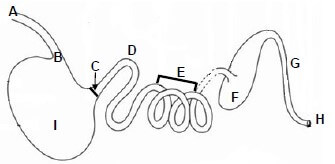
2.1.1 Classify the animal represented by the diagram above. (1)
2.1.2 Give a reason visible in the diagram for the answer in QUESTION 2.1.1 above. (1)
2.2 Identify the letter from the diagram above that represents the part where the following occurs:
2.2.1 It opens to move the pulp (1)
2.2.2 Brunner's gland secretes a liquid that protects the effects of the acids (1)
2.2.3 Fermentation of undigested food by micro-organisms (1)
2.2.4 Churning of bolus and gastric juice into chyme (1)
2.2.5 Food is mostly absorbed (1)
2.3 Urea and biuret are non-protein nitrogen substances which are given to ruminants only. Urea should be given with caution to ruminants.
2.3.1 Give a reason why urea is more poisonous than biuret. (1)
2.3.2 Indicate the precautionary measures a farmer can take to avoid urea poisoning in a lick. (1)
2.3.3 Name TWO ways in which the farmer can supplement urea to animals correctly. (2)
2.4 Young calves are not really ruminants when they are born. Functionally a calf is monogastric.
2.4.1 Suggest TWO reasons for the statement above. (2)
2.4.2 Indicate the period when the microbial population develops in the calf. (1)
2.4.3 State TWO ways in which the calf can benefit from the presence of microbial population. (2)
2.5 The table below shows the gross energy value as well as energy losses per kg in a 5 kg feed consumed by a cow.
ENERGY | VALUES (J/kg) | VALUES (J/5 kg) |
Gross energy | 18,5 | 92,5 |
Energy in faeces | 8,5 | 42,5 |
Energy in urine | 1,2 | 6 |
Energy lost as heat | 1,8 | 9 |
Energy in methane | 2,5 | 12,5 |
2.5.1 Calculate the digestible energy value in a 5 kg feed consumed by the cow. (2)
2.5.2 Determine the amount of energy that will be available to use for growth and production. (3)
2.6 A dairy farmer mixed maize meal and peanut oilcake meal at a ratio of 22 : 7,5 to prepare a meal with 18% DP.
Calculate the percentage of peanut oilcake meal in this mixture. (3)
2.7 A dairy farmer keeps 100 cows on a 500 ha pasture which supplies 1 200 kg DM per day for the first 6 months and 650 kg/day during the last 6 months.
The average daily animal's requirement to produce optimally is 60 kg with 70% concentrate and 30% roughage.
2.7.1 Calculate the monthly concentrate requirement of these cows. (3)
2.7.2 Work out the feed required against feed supplied during the last 6 months in tons. (4)
2.7.3 Comment on whether the quantity of the pasture available during the last 6 months is enough for dairy cows. (2)
2.8 Indicate the supplement which the farmer may consider to use in each of the following conditions:
2.8.1 To calm down cattle in a feedlot (1)
2.8.2 To improve growth of chicken by preventing harmful micro-organisms (1) [35]
QUESTION 3: ANIMAL PRODUCTION, PROTECTION AND CONTROL
Start this question on a NEW page.
3.1 The diagrams below illustrate facilities used in a production system. 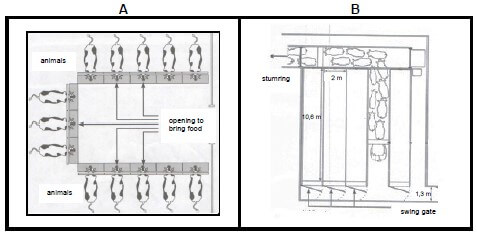
3.1.1 Identify the facility labelled A and B. (2)
3.1.2 Indicate the facility from the diagrams above that can be used when each of the following procedures is done:
(a) Sorting animals for auction sale (1)
(b) Feeding animals according to their specific needs (1)
3.1.3 The facility in B can be used to guide animals to a loading truck when they are going to be transported.
Name THREE guidelines when moving cows with calves. (3)
3.2 Farm animals have to be handled correctly when carrying out certain management practices.Give the reason for each of the following measures when handling animals:
3.2.1 Use of recognisable signal like touching the cow (1)
3.2.2 Not yelling when working with animals (1)
3.2.3 Grouping animals before transporting them (1)
3.3 The illustration below shows different spots one should consider when approaching farm animals. 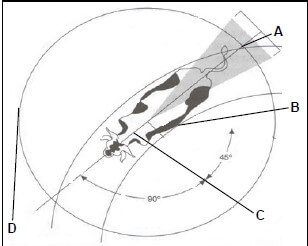
Indicate the letter that represents the following position:
3.3.1 The distance the animals like to keep between themselves and a threat to danger (1)
3.3.2 A point of balance (1)
3.3.3 An area in which an animal will kick when approached (1)
3.3.4 A handler initiates animal movement (1)
3.4 Compare in a table form subsistence and commercial production systems with regard to the following:
3.4.1 Purpose (2)
3.4.2 Management (2)
3.5 The seriousness of a disease depends on how the disease lasts and how quickly it develops. The table below shows the level of seriousness of the diseases.
Level of disease seriousness | Duration of the disease | Impact on animal |
A | Longer period | Mild |
Per-acute | B | Not deadly |
C | Short period | D |
3.5.1 Identify the labels A, B, C and D. (4)
3.5.2 Indicate a bacterial disease that is deadly within few hours of attack if not noticed immediately. (1)
3.5.3 Suggest TWO ways a farmer can prevent further spread of the disease in QUESTION 3.5.2 above from the dead animal. (2)
3.6 The picture below is a lifecycle of a parasite commonly found in sheep. 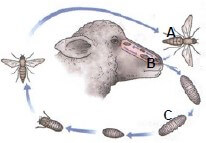
3.6.1 Give the name of a parasite above. (1)
3.6.2 Indicate the letter that represents the part where the following occurs:
(a) The larva pupate (1)
(b) The eggs are deposited into the nostrils (1)
3.6.3 Predict the season which favours infestation of the parasite. (1)
3.6.4 The parasite infestation can be visible from the host.
Name THREE signs that may be visible when an animal has been infested by the parasite above. (3)
3.7 Outline the role of the state to ensure the following:
3.7.1 Meat is not contaminated during the slaughtering process (1)
3.7.2 Prevention of introduction of disease from abroad (1)
3.7.3 Preventing an outbreak of a notifiable disease (1)
[35]
QUESTION 4: ANIMAL REPRODUCTION
Start this question on a NEW page.
4.1 The illustration below indicate the steps involved during a reproductive process. 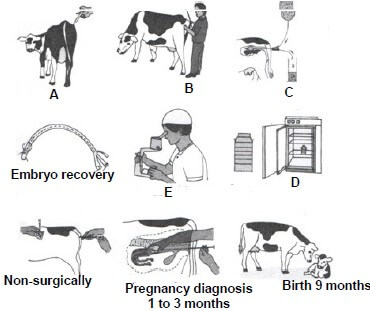
4.1.1 Identify the reproductive process illustrated above. (1)
4.1.2 Name TWO hormones that initiate the step labelled A. (2)
4.1.3 Provide the name given to animal labelled A. (1)
4.1.4 Indicate the temperature requirement in label D if the procedure is delayed up to 8 hours. (1)
4.1.5 Explain how the farmer can benefit from the process through the following:
(a) Non-producing and older cows (1)
(b) Economic benefit (1)
4.2 In female animals, hormonal and reproductive changes occur from one heat period to the next period. This occurs in phases which are marked by distinctive characteristics. Below are the characteristics applicable to each stage: 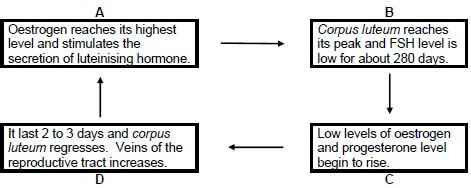
4.2.1 Match the characteristics labelled A, B, C and D with the phases of cycle. (4)
4.2.2 Indicate the letter that represent the stage where the following occurs:
(a) Graafian follicle ruptures to release the ovum (1)
(b) Ovum enters the fallopian tube for fertilisation and the ruptured follicle forms corpus luteum (1)
4.3 The diagram below is a reproductive system of a bull. 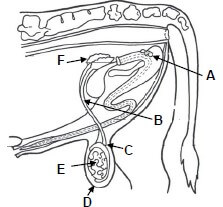
4.3.1 Indicate what is represented by part labelled B, D and F in the diagram above. (3)
4.3.2 Suggest TWO congenital defects in part labelled E that may lead to a complete loss of fertility in bulls. (2)
4.4 The bull may appear healthy and normal but shows no interest in cows due to several factors. Name the factor that is associated with each of the following statements:
4.4.1 Bull is used throughout the ploughing season (1)
4.4.2 Unbalanced ration to bull (1)
4.4.3 Young bull is raised in isolation (1)
4.4.4 Incorrect handling and care (1)
4.5 The table below shows the milk yield of two groups of lactating cows over 25 weeks.
MILK YIELD (litres) | ||
WEEKS | GROUP 1 | GROUP 2 |
1 | 5 | 10 |
5 | 10 | 15 |
7 | 30 | 35 |
10 | 25 | 20 |
15 | 15 | 10 |
20 | 13 | 7 |
25 | 10 | 5 |
4.5.1 Draw a line graph to show the milk yield of TWO groups of lactating cows over the 25 week period. (6)
4.5.2 Indicate the trend of milk yield in both groups over the lactation period. (1)
4.6 The diagram below shows the layers covering the foetus. Write down the letter and the name of the layer where the following occurs: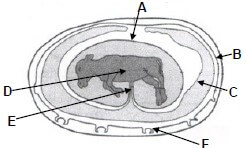
4.6.1 Collect the urine of the unborn calf (2)
4.6.2 Allows nutrient uptake, waste elimination through the mother (2)
4.6.3 Attaches the foetus to the caruncles (2) [35]
TOTAL SECTION B: 105
GRAND TOTAL: 150